AMD FX-8320E CPU Review: The Other 95W Vishera
by Ian Cutress on January 13, 2015 10:00 AM ESTF1 2013
First up is F1 2013 by Codemasters. I am a big Formula 1 fan in my spare time, and nothing makes me happier than carving up the field in a Caterham, waving to the Red Bulls as I drive by (because I play on easy and take shortcuts). F1 2013 uses the EGO Engine, and like other Codemasters games ends up being very playable on old hardware quite easily. In order to beef up the benchmark a bit, we devised the following scenario for the benchmark mode: one lap of Spa-Francorchamps in the heavy wet, the benchmark follows Jenson Button in the McLaren who starts on the grid in 22nd place, with the field made up of 11 Williams cars, 5 Marussia and 5 Caterham in that order. This puts emphasis on the CPU to handle the AI in the wet, and allows for a good amount of overtaking during the automated benchmark. We test at 1920x1080 on Ultra graphical settings.
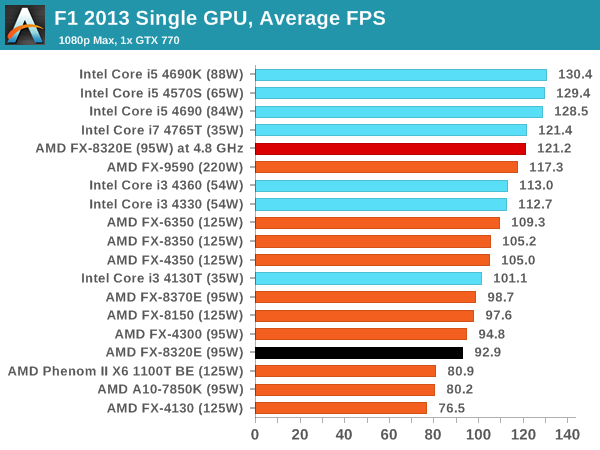
In both single and dual GPU cases, the stock performance of the FX-8320E falls behind the i3 CPUs by a 10-20 FPS margin, perhaps being noticeable on 120 Hz monitors. The minimum FPS on a single GPU still retains above 60 FPS, which is a plus.
Bioshock Infinite
Bioshock Infinite was Zero Punctuation’s Game of the Year for 2013, uses the Unreal Engine 3, and is designed to scale with both cores and graphical prowess. We test the benchmark using the Adrenaline benchmark tool and the Xtreme (1920x1080, Maximum) performance setting, noting down the average frame rates and the minimum frame rates.
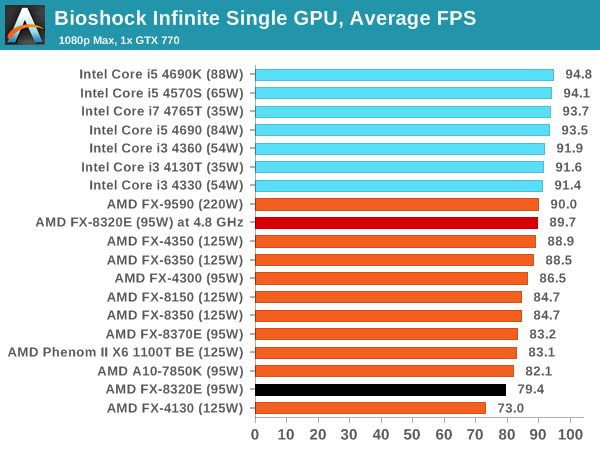
While average frame rates almost appear to be CPU agnostic, there is a clear AMD/Intel split here. More interesting is the minimum FPS results which seem to rely on IPC.
Tomb Raider
The next benchmark in our test is Tomb Raider. Tomb Raider is an AMD optimized game, lauded for its use of TressFX creating dynamic hair to increase the immersion in game. Tomb Raider uses a modified version of the Crystal Engine, and enjoys raw horsepower. We test the benchmark using the Adrenaline benchmark tool and the Xtreme (1920x1080, Maximum) performance setting, noting down the average frame rates and the minimum frame rates.
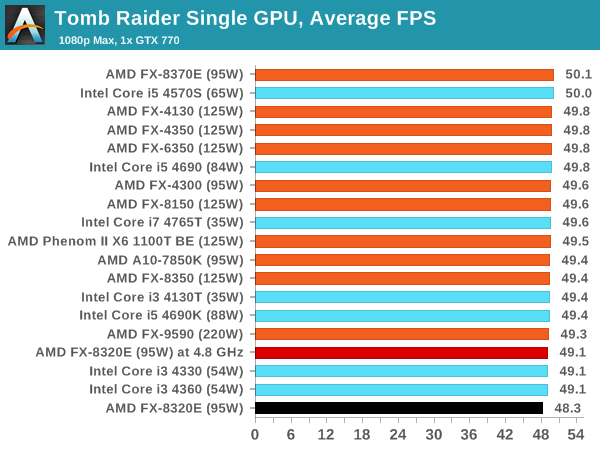
Tomb Raider still comes across as purely CPU agnostic.
Sleeping Dogs
Sleeping Dogs is a benchmarking wet dream – a highly complex benchmark that can bring the toughest setup and high resolutions down into single figures. Having an extreme SSAO setting can do that, but at the right settings Sleeping Dogs is highly playable and enjoyable. We run the basic benchmark program laid out in the Adrenaline benchmark tool, and the Xtreme (1920x1080, Maximum) performance setting, noting down the average frame rates and the minimum frame rates.
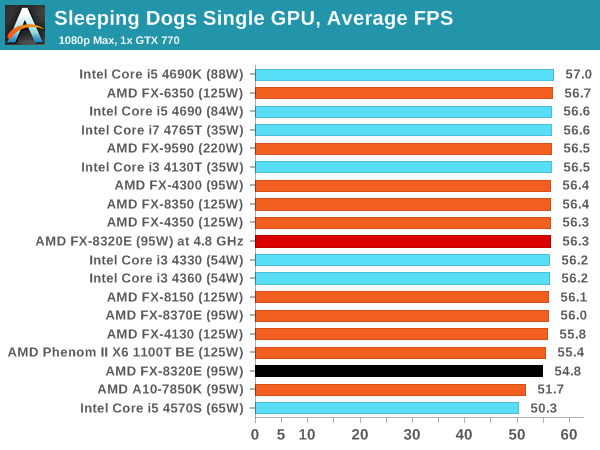
Single GPU usage puts the 8320E in the ballpark, but moving to dual GPUs sees an uplift in terms of the i5 CPUs for high refresh rate screens, albeit with the extra cost associated.
Battlefield 4
The EA/DICE series that has taken countless hours of my life away is back for another iteration, using the Frostbite 3 engine. AMD is also piling its resources into BF4 with the new Mantle API for developers, designed to cut the time required for the CPU to dispatch commands to the graphical sub-system. For our test we use the in-game benchmarking tools and record the frame time for the first ~70 seconds of the Tashgar single player mission, which is an on-rails generation of and rendering of objects and textures. We test at 1920x1080 at Ultra settings.
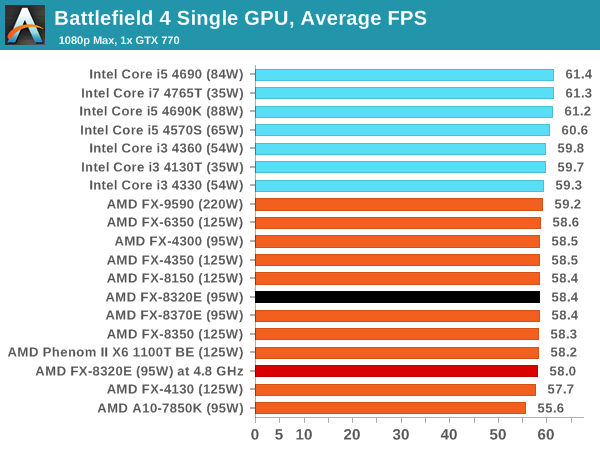
Single GPU shows little difference (despite a clear AMD/Intel separation line), but in dual GPU mode an i3 will make a 17 FPS rise, moving to 27 FPS with the i5 and more relevant to high refresh displays.















92 Comments
View All Comments
xenol - Tuesday, January 13, 2015 - link
Since I can't seem to edit (or it's not made obvious)...I wanted to point out if a program is "single-threaded", it's using a synchronous threading model, where in threads will wait in line to be run. I'm pretty certain a lot of modern programs are asynchronous.
eanazag - Tuesday, January 13, 2015 - link
With an updated chipset and new manufacturing node, this CPU could still play in the market.At release the 900 series chipset was better than Intel's current solution which had no USB 3 and no SATA 3. It took a generation too long for Intel to catch up with SATA 3 (Sandy Bridge). At Ivy Bridge Intel passed AMD in every aspect.
We're talking Broadwell now and it is plain sad at this point. The Core i3's from Haswell beat the processor much of the time when not overclocked. The value proposition is not in AMD's favor unless some just wants to overclock something.
hojnikb - Tuesday, January 13, 2015 - link
>At release the 900 series chipset was better than Intel's current solution which had no USB 3 and no SATA 3Not really. 900 didnt have native usb3 (so pretty much the same deal as intel -- they had to use 3rd party solution). And in 2009, sata6g wasn't really a thing yet (no fast ssds back then).
hojnikb - Tuesday, January 13, 2015 - link
correction; 900 series was released in 2011, where sata6g ssds started to pop up...Laststop311 - Tuesday, January 13, 2015 - link
You just can't defend these FX line cpu's. You are a just a million times better off coughing up an extra 200 dollars and getting a nice z97 board + devils canyon i5 and overclocking it to an easy 4.4ghz. Even in software that can make use of all 8 cores for BD a 4.4ghz i5 devils canyon has a good chance of out muscling it or coming very close and for anything else the i5 just blows BD away.If you are going to buy an AMD FX based system just stop yourself and put 50 dollars away on your next 4 paychecks and get an i5-4690k + Z97 system instead and u will be much happier. Even if for some reason i had to have 8 cores in my next system i'd spend an extra 1400 or whatever and get an i7-5960x + x99 system. It's disgusting that an 4.0+ghz overclocked phenom II x6 1100t can outperform the new FX chips at MANY tasks and I would actually recommend an AMD buyer to just get an 1100t with quality water cooling over a current FX chip can find super cheap 1100t's which makes the 1100t + good water cooling the same price as a new FX + decent air cooler and u can just get better performance with the massively OC'd 1100t.
III-V - Tuesday, January 13, 2015 - link
>You just can't defend these FX line cpu's.Oh yes you can. There are thousands of people in the AMD Defense Force that do just this every day.
silverblue - Wednesday, January 14, 2015 - link
Haha I like this one. :)jabber - Thursday, January 15, 2015 - link
To me the difference is like going into a restaurant and ordering the AMD pizza which comes in at 15" for $20 or ordering the Intel pizza which is 18" and costs $5 more. Most people probably can't manage to eat the AMD let alone the Intel.It's not like we are back in the days with AMD stuck at 20 FPS average and Intel at 30FPS average.
Oxford Guy - Thursday, January 15, 2015 - link
That's a really awful analogy. If your primary taxing use for your computer is gaming then AMD processors are a poor option.jabber - Friday, January 16, 2015 - link
Not really."Oh noooo my $100 AMD chip is only giving me 86FPS!" How terrible!
How did we manage back in the 1990's.